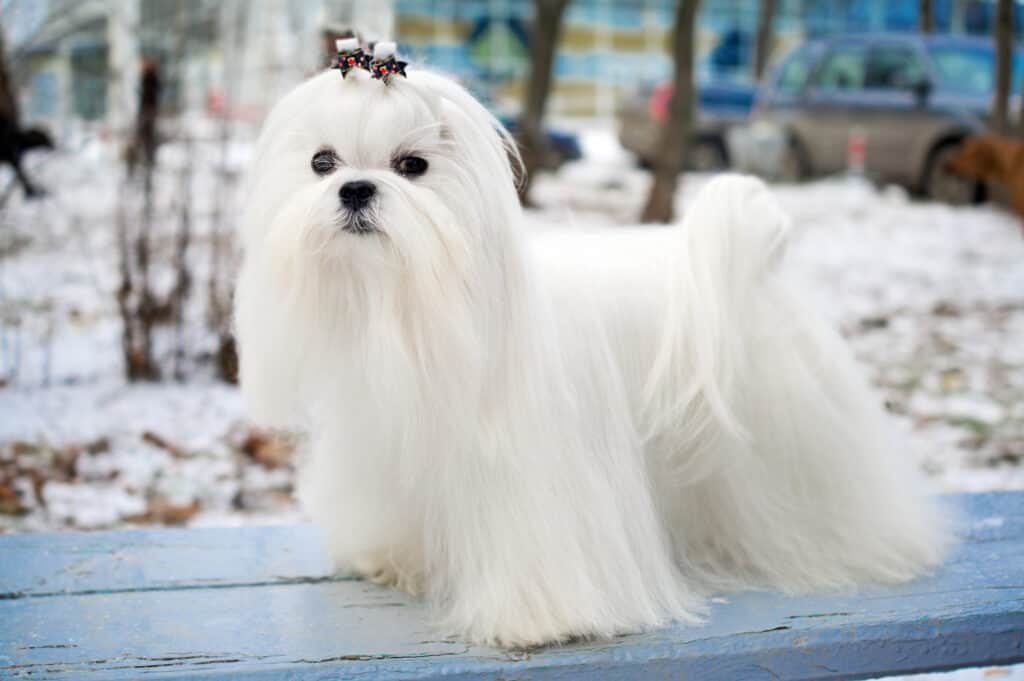Standard Maltese colors do not allow for much variety. The standards (or set of rules that describe what a breed is supposed to look and act like) for this breed across registries worldwide require a pure white coat. Some allow for tan or lemon markings on the ears. However, in some registries, these markings constitute a fault or are undesirable. That means the Maltese may lose points in the show ring when these other colors are present. Because standard Maltese only come in white, we will also discuss the two non-standard color markings that can appear in the breed.
First, let’s learn briefly about the history, personality, and care of the Maltese.
A Brief History of the Maltese
Ye Ancient Dogge of Malta, commonly called the Maltese, originated on the Mediterranean island of Malta some 5,000 years ago. Many assume the little white dogs made their way to the port hub island with the Phoenicians when they came to trade. Then, during the reign of the Roman Empire, the Maltese became a status symbol. High-born women often carried them as a display of their family’s success. Maltese played a significant role in Roman myths, poems, and fables where they symbolized loyalty. Legend has it that Saint Paul even received one of these spirited little dogs as a gift when he healed the father of a Roman governor. After the fall of the Roman Empire, Chinese breeders stepped in to save the breed from extinction. They were instrumental in the re-creation of the breed as we know it today.
Maltese Personality and Care
The lively and active Maltese may only come in one color, but they make great companions! Typically described as being fearless, Maltese are happy to go on walks and play with their owners. They do require regular brushing and haircuts along with a bathing regimen that includes both shampoo and conditioner to keep their beautiful coats healthy. Maltese tend to be lapdogs and enjoy spending time snuggling with their family in bed or on the couch. However, they are prone to excessive barking and separation anxiety. This breed also has a number of health concerns though they do tend toward a longer lifespan.
The Standard Maltese Color: White

The most common color for Maltese is pure white with a black nose, paw pads, and eye rims.
©iStock.com/Laures
According to the American Kennel Club (AKC) standard for the Maltese coats and colors:
“The coat is single, that is, without undercoat. It hangs long, flat, and silky over the sides of the body almost, if not quite, to the ground. The long head-hair may be tied up in a topknot or it may be left hanging. Any suggestion of kinkiness, curliness, or woolly texture is objectionable. Color, pure white. Light tan or lemon on the ears is permissible, but not desirable.”
The standard is written this way not just in the AKC but across every dog registry we could find. For this reason, breeders tend toward only keeping white Maltese in their breeding programs. Off-standard dogs sometimes bring in larger sums due to their rarity. However, a responsible breeder’s goals include improving the breed rather than making a ton of money on non-standard dogs.
Show dogs lose points for non-standard coloration or other faults and will not win as many awards. Therefore, most breeders prefer to eliminate them from the gene pool. That means non-standard colors are more often sold as pets rather than kept or sold for breeding elsewhere.
Non-Standard Maltese Color Markings: Tan

White and tan Maltese have light tan or cream coloration on the ears.
©Ermolaeva Olga 84/Shutterstock.com
Some Maltese have or develop tan color markings on the ears. This color can range from dark orange-like color to very light beige. The color may become less noticeable as the puppy grows but is still considered a fault in show dogs.
It’s important to note, that Maltese color markings only refer to non-standard coloration on the ears. Maltese dogs do not have spots of color on their body like other breeds. Telling the difference between pure white Maltese and non-standard colors may be very difficult until the dog reaches adulthood with their full adult coat. However, tan markings on the ears can frequently be seen much sooner. Also, the coloration on the ears may fade as the dog grows. Alternately, the color may become darker. The coloration on the ears does not mean a Maltese isn’t purebred, it just means they are not of show quality.
Non-Standard Maltese Color Markings: Lemon

Lemon markings on the ears appear as very soft cream, barely noticeable.
©Ermolaeva Olga 84/Shutterstock.com
More rare than tan color markings, lemon color on the ears is also seen in Maltese. Lemon is described as extremely pale cream. This color is the result of displaying both the genes for liver and pigment reduction.
Final Thoughts on Maltese Colors
Although Maltese only come in one color per the breed standards around the world, they sometimes have tan or lemon color markings on the ears. While these markings may cost them points in the show ring, the non-standard colored Maltese are still purebred animals and make great pets!
The photo featured at the top of this post is © Jolanta Beinarovica/Shutterstock.com
Ready to discover the top 10 cutest dog breeds in the entire world?
How about the fastest dogs, the largest dogs and those that are -- quite frankly -- just the kindest dogs on the planet? Each day, AZ Animals sends out lists just like this to our thousands of email subscribers. And the best part? It's FREE. Join today by entering your email below.
Thank you for reading! Have some feedback for us? Contact the AZ Animals editorial team.






